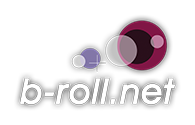A few thoughts on this topic.
Multi-camera network interviews have been the staple of my career for the past twenty years or so. In fact, dazapper and I have worked on countless segments of these magazine programs together over the years.
It isn't as easy as it looks. And if looks easy -- meaning the lighting looks natural and unforced -- well that's the way good magazine lighting is supposed to be. However, every situation is different in terms of difficulty. The best method for two camera lighting (as it is with one camera) is to key from the side where the person is looking; the key light stands almost alongside the interviewer and the interviewee looks right into it. But when the task gets more difficult -- when the room is too small, when there isn't enough time to do an optimal lighting set up, when one crew is setting up both cameras -- then corners get cut and "mistakes" get made.
I watched the interview in question. The room is very small -- you can see it towards the end when they cut to a wide shot with all the gear in it. They have no natural background so the DP is using a backdrop. Maybe -- just maybe -- there is a third camera they had hoped to use making a wide two shot and they didn't know how to do it with the keylights on the inside of the axis. You never know what problems were being worked around.
I mention none of that to excuse the look. I think lighting from the off side is GENERALLY the wrong thing to do. But there are times when you might need to do it so I never say "never".
As for the awkward framing on 60 Minutes interviews, here's why I think that happens sometimes. Basically the crews are shooting 16x9, but 4x3 safe. All they have are little markers (if they are on) to keep themselves honest. But sometimes the 16x9 framing becomes compelling and they cheat a little and maybe they go outside the safe area for 4x3. So they are not really framed optimally for either 4x3 or 16x9 but somewhere in between. Again, I'm not excusing it. Just explaining why things might look the way they do.
I am satisfied with about sixty percent of the interviews that I shot when I see them on television. I saw an interview I did that played on a recent broadcast and I was struck by how I had gotten the fill light a little wrong. It was stronger than I like it to be. I wondered why I hadn't seen that on my monitor (Panasonic 17" HD) in the field. Your monitor tells you everything you need to know about the image you are lighting and if there is a gap between what you think you saw in the field and what actually makes it way onto television, then you have to go back and make sure that your monitor is set-up more honestly. It takes time and a lot of organic feedback -- watching stuff you shot on television -- to make the small tweaks that build trust between you and your monitor. You also have to really look at what you are doing in the field and not just light in a rote, robotic fashion. You have to use your eyes critically. We light to 17" professional monitors. We watch these programs on 50" consumer televisions. When you make a small miscalculation (as I felt I might have on the interview I watched recently) you have to keep that in mind the next time out. Your look is your calling card. It sells you. You have to take it very seriously. Or so I think.
